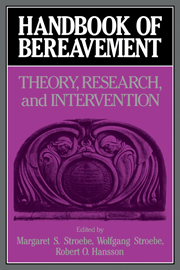Book contents
- Frontmatter
- Contents
- Contributors
- Preface
- Part I Introduction
- Part II The phenomenology and measurement of grief
- 2 The course of normal grief
- 3 Pathological grief reactions
- 4 Measurement issues in bereavement
- Part III Current theories of grief, mourning, and bereavement
- Part IV Physiological changes following bereavement
- Part V The psychological, social, and health impacts of conjugal bereavement
- Part VI Grief reactions to different types of loss
- Part VII Coping, counseling, and therapy
- Part VIII Conclusions
- References
- Author index
- Subject Index
4 - Measurement issues in bereavement
Published online by Cambridge University Press: 04 May 2010
- Frontmatter
- Contents
- Contributors
- Preface
- Part I Introduction
- Part II The phenomenology and measurement of grief
- 2 The course of normal grief
- 3 Pathological grief reactions
- 4 Measurement issues in bereavement
- Part III Current theories of grief, mourning, and bereavement
- Part IV Physiological changes following bereavement
- Part V The psychological, social, and health impacts of conjugal bereavement
- Part VI Grief reactions to different types of loss
- Part VII Coping, counseling, and therapy
- Part VIII Conclusions
- References
- Author index
- Subject Index
Summary
To date there is no common strategy for assessing the psychological reaction to bereavement. Widely differing measurement approaches reflect the complex nature of the phenomenon, as well as the diversity of purpose among researchers and practitioners. The essential question is how to measure grief in any meaningful sense. The emotional reaction to the loss of a loved one is particularly complex in that it tends to involve cognitive, affective, behavioral, physiological, and social symptoms (cf. W. Stroebe & Stroebe, 1987). Moreover, each of these can be assessed at several levels. The physiology alone might be assessed as part of the symptomatology (experience) of grief itself, such as hypoarousal or gastrointestinal problems; as disruption in related systems, such as immunologic or endocrine markers (Irwin & Pike, this volume; Laudenslager, Boccia, & Reite, this volume; Kim & Jacobs, this volume); or as consequences of grief, such as long-term epidemiological outcomes (McCrae & Costa, this volume). Similarly, assessment might proceed from particular perspectives, such as stress and coping.
In addition, grieving is thought to progress through somewhat overlapping stages of resolution (cf. Weiss, this volume; Shuchter & Zisook, this volume), and given symptoms may be present at several stages, although more characteristic of some stages than others. Thus, any given clinical picture should probably be viewed within its temporal context. Validation strategies for a grief instrument, therefore, often include an assessment of whether the nature and intensity of symptoms vary as expected over time.
Information
- Type
- Chapter
- Information
- Handbook of BereavementTheory, Research, and Intervention, pp. 62 - 74Publisher: Cambridge University PressPrint publication year: 1993
Accessibility standard: Unknown
Why this information is here
This section outlines the accessibility features of this content - including support for screen readers, full keyboard navigation and high-contrast display options. This may not be relevant for you.Accessibility Information
- 21
- Cited by
